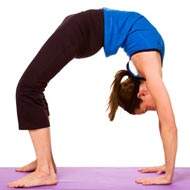Upward Bow (Urdhva Dhanurasana)
The Urdhva Dhanurasana or Upward Bow or Wheel Pose is a pose that targets the spine and the muscles of the back. This is one of the classic Yoga postures and may be performed by beginners and advanced practitioners alike.
The Upward Bow pose may be practiced by beginners, while advanced practitioners can perform the Wheel Pose. Let us take a look at the steps that are needed to perform the Urdhva Dhanurasana.
Steps :
- Lie down on your back with your knees bent and feet flat on the ground about shoulder distance apart.
- Place both palms on the floor on either side keeping your as close to your chest as possible. Your fingers should point towards your feet.
- Inhale and slowly push your pelvis off the floor. Use your core muscles to push your trunk as high as you can.
- Try to keep your trunk perpendicular to the floor while supporting yourself on your hands and feet. Allow your head to hang back and breathe easily through the nostrils. This pose is also known as the Bridge Pose. If you are just starting out, you should attempt to maintain this pose for as long as you can and skip the proceeding upward bow steps.
- Advanced practitioners should now attempt to arch their back while bringing their hands closer towards the shoulders so that the back forms a concave arch with the floor. This is the Upward Bow pose. .
- If you want to further increase the difficulty of this exercise, lift one leg off the floor and straighten it so that it is parallel to the floor. This is known as the Wheel Pose. .
- To get out of the pose, first return slowly to the Bridge Pose. Then allow your back to gently touch the floor and return to the starting position.
Precautions :
- Avoide the pose or practicing with care if you suffer from back injury, carpal tunnel syndrome, diarrhea, headache, heart problems, and low or high blood pressure.
- If you have weak wrists, perform the pose with your hands pointing in the opposite direction to your feet. This will reduce the strain on your wrists.
Beginner’s Tip :
A good beginner’s tip for Upward Bow is to secure and loop a strap a little above the knees and around the thighs so that the thighs are held at hips width and are parallel to each other. This is helpful because the feet and knees tend to splay while you raise yourself into the pose, compressing the lower back.
Benefit To Body Part :
- It helps to strengthen the forearms, shoulders, and wrists.
- It helps in strengthening the legs.
- The Upward Bow pose also helps in toning the buttocks.
- This Yoga pose is also very beneficial in increasing the strength and flexibility of the back, spine, and abdomen.
- It also helps in stretching the rib cage, lungs, and chest.
- The Upward Bow is also an excellent stretch for the biceps and triceps.
Therapeutic Applications :
- Treatment of osteoporosis.
- Counteracting depression
- Increasing energy.
Variations :
- The Bridge Pose
- The Upward Bow Pose
- The Wheel Pose
Preparatory Poses :
- Cobra Pose (Bhujangasana)
- Hero pose (Virasana)
- Upward Facing Dog (Urdhva Mukha Svanasana)
- Bridge Pose (Setu Bandha Sarvangasana)
Follow up poses
- Half Spinal Twist (Ardha Matsyendrasana)
- Reclined Big Toe pose (Supta Padangusthasana)



